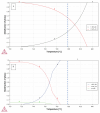Effect of 3 wt% Cu on the Microstructure and Hardness of a Ti-10Ta-1.6Zr Alloy
- PMID: 40649653
- PMCID: PMC12251167
- DOI: 10.3390/ma18133163
Effect of 3 wt% Cu on the Microstructure and Hardness of a Ti-10Ta-1.6Zr Alloy
Abstract
Alloys of Ti-10Ta-1.6Zr (wt%) with and without 3 wt% Cu made by arc-melting, heat-treated in two stages and quenched to have α + β microstructures were studied. These alloys were studied for potential replacement of Ti-6Al-4V alloys because Ta and Zr are more biocompatible than Al and V, and copper was added for potential antimicrobial properties. The heat-treated samples were investigated by SEM-EDX, transmission Kikuchi diffraction (TKD) and XRD. When studied at a higher magnification, the heat-treated alloys revealed a bi-lamellar microstructure, consisting of broad α lamellae and β transformed to fine α' lamellae with various orientations. The fraction β transformed to fine α' lamellae was higher in the alloy with Cu than that without Cu. Furthermore, copper was found to lower the solubility of tantalum in the β. The hardest alloy was the heat-treated alloy containing Cu, albeit with a wide standard deviation, probably due to the high fraction of martensitically transformed β.
Keywords: copper; hardness; microstructure; tantalum; titanium.
Conflict of interest statement
The authors declare no conflicts of interest.
Figures














References
-
- Ramakrishna S., Mayer J., Wintermantel E., Leong K.W. Biomedical applications of polymer-composite materials: A review. Compos. Sci. Technol. 2001;61:1189–1224. doi: 10.1016/S0266-3538(00)00241-4. - DOI
-
- Patel N.R., Gohil P.P. A Review on Biomaterials: Scope, Applications and Human Anatomy Significance. Int. J. Emerg. Technol. Adv. Eng. 2012;2:99–101.
-
- Geetha M., Singh A.K., Asokamani R., Gogia A.K. Ti based biomaterials, the ultimate choice for orthopaedic implants—A review. Prog. Mater. Sci. 2009;54:397–425. doi: 10.1016/j.pmatsci.2008.06.004. - DOI
Grants and funding
LinkOut - more resources
Full Text Sources

